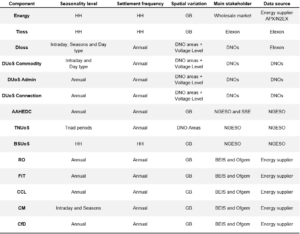Stakeholders
In this section, you will learn that there are some stakeholders that play important roles in the electricity sector dynamics. So it is useful to know them and their influences.
Navigate through the main sections:
Main Stakeholders
BEIS
Established in 2016, the Department for Business, Energy and Industrial Strategy (BEIS) is responsible for the energy policy in the UK, leading government policies about business, climate change, energy and clean growth, industrial strategy, science, research and innovation. Lately, the government energy policy has been determined by three main objectives, commonly known as the “energy trilemma”, affordability, decarbonisation and security (Bolton and Hinson, 2020). BEIS is the main stakeholder together with Ofgem responsible for setting the government obligations tariffs.
Ofgem
Created in 2000, as a non-ministerial department, the Office of the Gas and Electricity Markets (Ofgem) is the energy market regulator, working independently but supporting governmental energy strategies. Ofgem regulates and licenses the generation, transmission and supply of electricity, aiming to protect the interests of existing and future consumers (Ofgem, 2021).
National Grid
The transmission system is operated by the National Grid Electricity System Operator (NGESO), which is part of the National Grid Group. NGESO balances the electricity generation and demand in real-time for system stability. NGESO is also the main stakeholder responsible for setting the TNUoS, BSUoS and in part for the AAHEDC.
DNO Companies
The distribution grid is regionally owned and operated by the Distribution Network Operators (DNOs), divided into 14 areas. There are six DNO companies: Electricity North West, Northern Powergrid, Western Power Distribution, UK Power Networks, Scottish Power Networks, and Scottish and Southern Energy Power Distribution. DNOs are responsible for setting the DUoS components for each of their regions.
Nominated Electricity Market Operators
The power exchange market, where the wholesale electricity is traded, has two nominated electricity market operators, the European Power Exchange EPEX SPOT SE, which controls the APX Power UK, and the Nord Pool Group (N2EX). It is in these two power exchange markets that the auctions for day-ahead and intraday trades happen. The electricity commodity cost is influenced by the wholesale electricity market trading dynamics.
Elexon
Elexon is the company responsible for the administration of the Balancing and Settlement Code. This code considers the agreed contracts in advance between generators and suppliers and the actual volumes that were generated and used, so Elexon is responsible for settling accurate payments for each generator and supplier involved. Elexon is also responsible for calculating the Dloss and Tloss components.
Stakeholders and Bill Components Summary
Here is a summary of the main electricity bill components including the main stakeholders responsible for setting each component. It also shows each component’s seasonality level, settlement frequency, spatial variation and data source.

Want to know more about your electricity costs and participate in our project?
We are looking for non-domestic energy consumers to engage with our online resources, provide ideas, feedback and become more energy aware in this complex and dynamic energy context!